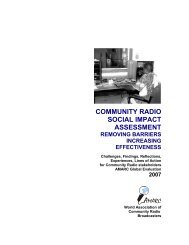Women's Empowerment and Good Governance Through - amarc
Women's Empowerment and Good Governance Through - amarc
Women's Empowerment and Good Governance Through - amarc
Create successful ePaper yourself
Turn your PDF publications into a flip-book with our unique Google optimized e-Paper software.
83<br />
Best Experiences for an Action Research Process<br />
logue, as well as a significant tool for the promotion of active non-violence strategies, including<br />
the convening of the weekly Blue Ribbon Peace Vigil in Suva.<br />
In Fiji, the formal process of negotiation established as a result of the Eminent Persons Report<br />
continues to negotiate only with the Interim Administration without offering a formal space<br />
through which women in all our diversities can inform <strong>and</strong> contribute. It is now time for the<br />
women of Fiji, through civil society leaders who are committed to the realization of a just’<br />
peace <strong>and</strong> women’s human rights are involved <strong>and</strong> supported to review <strong>and</strong> define a more<br />
gender-inclusive – community empowerment process for the return to parliamentary democracy<br />
by March 2009. Otherwise, the road map for Fiji will not highlight the realities of women<br />
in all our diversities.<br />
Community radio is the vehicle – “to increase the options <strong>and</strong> opportunities for Pacific women,<br />
especially those living in poverty, by offering them a ‘space’ to ensure they are able to participate<br />
in <strong>and</strong> shape political decision making at all levels toward a more gender-responsive<br />
<strong>and</strong> people-centred governance that puts the interest of the whole society, especially the poor,<br />
above the traditional politicians’ <strong>and</strong> elites’ interests (40).”<br />
Women’s experiences as a result of Fiji’s political history of internal conflicts have also meant<br />
dealing with new social <strong>and</strong> economic problems, but unfortunately mainstream media <strong>and</strong> government<br />
based information sources have not provided a multi-ethnic vehicle for people from all<br />
our ethnic <strong>and</strong> communities, to collectively articulate their views on issues <strong>and</strong> stories.<br />
Women’s limited access or even inability to access media, let alone technology, is actually a<br />
reflection of the personal, institutional <strong>and</strong> systematic barriers, including traditional practices,<br />
at work in many societies. Other drawbacks include gender barriers such as illiteracy, time<br />
constraints, costs, geographical location <strong>and</strong> social cultural norms, which mean women have<br />
to continue to play ‘development catch up’. These are important factors for consideration, if we<br />
want to ensure the women’s perspective at all levels of decision making <strong>and</strong> implementation;<br />
after all, one of the best ways to mainstream the gender perspectives is through the media.<br />
Community media as a vehicle for empowerment <strong>and</strong> transformation<br />
femLINKpacific develops, produces <strong>and</strong> distributes a range of women’s Community Media

















